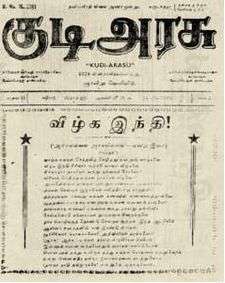Kudi Arasu
Kudi Arasu (also pronounced as Kudiyarasu; English: Republic) was a Tamil weekly magazine published by Periyar E. V. Ramasamy in Madras Presidency (present-day Tamil Nadu) in India.
| Periyar E. V. Ramasamy |
|---|
| Ideologies |
| Activities |

History
Periyar started Kudi Arasu on 2 May 1925 in Erode[1] with K. M. Thangaperumal pillai as the editor. Its initial publications were issued weekly on Sunday with 16 pages at a cost of one anna. In November 1925, Periyar quit the Indian National Congress after his failed attempt to bring reservation for non-Brahmins in educational institutions and government jobs.[2] He started the Self-Respect Movement to propagate self-respect among Indians, especially Tamils. The magazine became the mouthpiece of the movement.[3][4] The magazine circulated in the Tamil diaspora, for which Thamizhavel G. Sarangapani played a prominent role.[5] It had Periyar's wife Nagammai, his sister Kannammal[1] and his brother E. V. Krishnasamy[6] as the publisher for a period of time when he was on tour or arrested. It ceased publication on 5 November 1949.
Publications
Periyar wrote several articles on women's rights, on atheism and against the caste system. Others like M. Singaravelu wrote many articles on socialism.[7]
In an editorial dated 29 March 1931, Periyar criticised Mahatma Gandhi for Bhagat Singh's death.[6] He wrote,
There is no one who has not condoled the death of Mr. Bhagat Singh by hanging. There is none who has not condemned the government for hanging him. Besides, we now see several people known as patriots and national heroes scolding Mr. Gandhi for the happening of this event.[8]
The Madras government of the British Raj banned the magazine at several occasions for various reasons including sedition and for propagating communism. In 1935, the Tamil version of Why I am an Atheist was banned,[9] and translator P. Jeevanandham and publisher E.V. Krishnasamy were arrested.[6]
In recent times
In 2010, works from between 1925 and 1938 were reproduced and published as books.[10]
References
- K. Srilata (2003). The Other Half of the Coconut: Women Writing Self-respect History : an Anthology of Self-respect Literature (1928–1936). Zubaan. pp. 25–26. ISBN 978-81-86706-50-3.
- S. Muthiah (2008). Madras, Chennai: A 400-year Record of the First City of Modern India. Palaniappa Brothers. p. 354. ISBN 978-81-8379-468-8.
- Maithreyi Krishnaraj (27 April 2012). Motherhood in India: Glorification without Empowerment?. Taylor & Francis. p. 203. ISBN 978-1-136-51779-2.
- Chandra Mallampalli (31 July 2004). Christians and Public Life in Colonial South India, 1863–1937: Contending with Marginality. Routledge. p. 176. ISBN 978-1-134-35025-4.
- "Thamizhavel G. Sarangapani". The Modern rationalist. tamilnation.co. Retrieved 21 March 2014.
- "Periyar admired Bhagat Singh, criticised Gandhiji". The Hindu. 22 August 2011. Retrieved 21 March 2014.
- Gail Omvedt (1 January 2006). Dalit Visions: The Anti-caste Movement and the Construction of an Indian Identity. Orient Blackswan. p. 57. ISBN 978-81-250-2895-6.
- Bhagat Singh; Bhupendra Hooja (2007). The Jail Notebook and Other Writings. LeftWord Books. pp. 189–. ISBN 978-81-87496-72-4.
- Kanchi Venugopal Reddy (2002). Class, Colonialism, and Nationalism: Madras Presidency, 1928-1939. Mittal Publications. pp. 85–. ISBN 978-81-7099-854-9.
- "Periyar's speeches, writings released". The Hindu. 12 June 2010. Retrieved 22 March 2014.